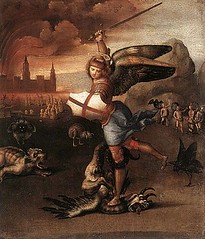On August 10th 846 the marquis Adalbertus of Tuscany, who watches over Corsica, writes to the pope to warn him of a near attack of the Arabs. But it is too late.
On August 28th 846 the Arabs arrived at the mouth of the river Tiber and they sailed towards Rome.
From Civitavecchia an army started the descent by land in direction of Rome.
Another army began the march from Portus and Ostia.
They didn't succeed in entering the enclosing walls, validly defended by the Romans, but the churches of St. Peter and St. Paul, outside the boundaries, were violated by the Arabs.
Uselessly Saxons, Longobards, Frisians and Franks defended St. Peter up to the last man. The Arabs brought away all the treasures of St. Peter, they tore the silver leaves of the doors, the gold foils of the floor of the confession, devastated the bronzy crypt of the apostle, took the gold cross that stood on the grave of Peter. They laid waste all the churches of the district Suburb.
The marquis Guy of Spoleto, arrived to help Rome, succeeded in defeating the Arabs who withdrew partly towards Civitavecchia and partly towards Fondi, following the Appian Way.
The Arabs' passage, in flight, provoked ruin and devastation in all the Roman country.
At Gaeta the Longobard army clashed again with the Arabs. Guy of Spoleto found himself in serious difficulties, but the Byzantine troops of Cesarius, son of Sergius, magister militum in Naples, arrived in time.
In November of 846 a storm provoked numerous damages to the ships of the Arabs, some of which were shipwrecked on the coast.
The pope Leo IV, in consequence of the attack against St. Peter, in 848 undertook the construction of the Civitas Leonina to protect the Vatican hill. The enclosing walls were completed in June 27th 852.
Source: Maat.it: The Arabs attack Rome
Tuesday, November 6, 2007
Muslims sack the capital of the Christian Church
Subscribe to:
Post Comments (Atom)




No comments:
Post a Comment